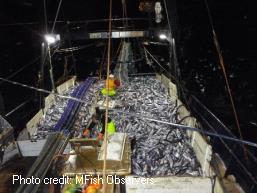Hoki is widely distributed throughout New Zealand waters in depths of 200m to 600m.
The main hoki spawn fishery operates from mid-July to late-August on the WCSI where hoki aggregate to spawn. A second major spawning fishery occurs in Cook Strait where the season runs from late-June to mid-September peaking in July and August. Small catches of spawning hoki are taken from other spawning grounds off ECSI and, late in the season, at Puysegur Bank.
Outside the spawning season there is a substantial fishery on the Chatham Rise and a smaller fishery in the Sub-Antarctic. The Chatham Rise fishery generally has constant catch levels across all months except July to September when catches are lower because fishing vessels move to the spawning grounds. In the Sub-Antarctic, catches typically peak in April to June. There is also a small ECNI hoki fishery.
The hoki trawl fishery has interactions with a range of protected species, most notably seabirds, fur seals and interactions with the benthic habitat in the predominantly bottom trawl fishery on the Chatham Rise.
The hoki fishery, largely because of its size, is one of the most commercially valuable fisheries in New Zealand. In 2008 the total market value of hoki quota was estimated to be $730m.
Hoki is also one of the most important export earners for the fisheries

sector. In 2008, 29,000 tonnes (product weight) of hoki was exported, realising a value of $104m. The destination for much of these exports is China where the product is further processed for re-export into Europe and the USA. Almost all hoki exported is as frozen product. There is a limited domestic market for hoki where it is sold frozen through supermarkets.
The hoki fishery received Marine Stewardship Council Certification in 2001 and was recertified as a sustainably managed fishery for a further five years in 2007.
For the latest updates and news (including stock assessment) on the Hoki fishery, please
click here.